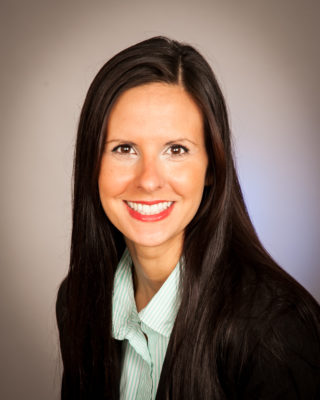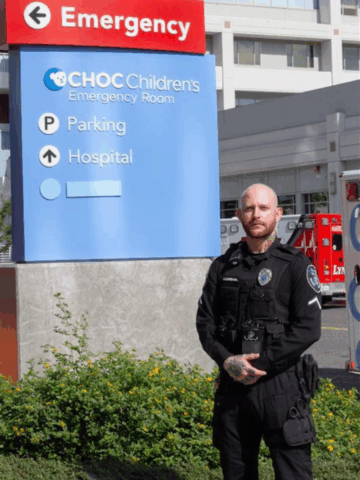By Lisa Turni, surgical unit nurse manager, CHOC

I’ve been a nurse for 18 years, but the seeds of my career were planted long before I put on my first pair of scrubs. Although I didn’t know it at the time, having surgery as a teenager would ultimately inspire my career path.
Growing up, I was an athlete and especially loved playing basketball. Although I was in good shape, I was always out of breath and would hyperventilate often. I felt insecure because I thought I was giving my best at practice.
When I was 14 years old, my mom took me to the pediatrician who initially assumed I had asthma. But when my doctor lifted my shirt to listen to my breathing, she noticed a depression in my chest. I had always known it was there, but I thought that’s just how my chest looked. He diagnosed me with pectus excavatum, commonly referred to as “sunken chest.” This is when the breastbone, or sternum, and some of the ribs grow abnormally and cause a depression in the middle of the chest. Pectus excavatum is the most common congenital chest wall abnormality in children. Many cases of pectus excavatum are found in the early teenage years because growth spurts during puberty can exacerbate the chest depression.
I was referred to a surgeon, who explained that the depression in my chest was pushing down on my heart and lungs, which make it harder for them to work properly, and harder for me to breathe properly. He told me that I would need surgery to correct the deformity in my chest wall. I hadn’t realized there was anything I could do to fix it. He explained that during surgery, he would make an incision across my chest and reshape my rib cartilage which would keep my breastbone in the correct position.
As my surgery date got closer, I became more aware of the depression in my chest, and the way I thought about and saw myself started to change.
At that age, kids at school can be harsh. Sometimes they would unknowingly ask hurtful questions like, “Oh, why does your chest look like that?”
I started to realize I was different. Not necessarily all of the kids and comments were mean, but I was aware that I stood out. I changed the types of bathing suits and clothing I wore to hide the depression in my chest, a behavior I now know is common among pectus excavatum patients.
A physical abnormality is an emotional thing to shoulder as a child. It can be hard for others to understand how much it can affect a child emotionally. When I became a nurse, I used that understanding to inform the care I provided to my patients.
My surgery went well, and although that occurred in the days before the minimally-invasive Nuss procedure was invented, my surgeon was able to “hide” my scar near my bra line so it wouldn’t show in bathing suits or other clothing. The scar became a badge of honor. It was a sign of my courage.
My hospital stay after surgery is what led me to pursue nursing. I knew from that hospital stay that I wanted to help other kids. Some of my providers during that time got frustrated with me because I couldn’t take a deep breath or cough due to pain. Even though pain management has improved tenfold in the years since, the way my care team acted toward me has made me want to always treat patients better than they did.
After eventually getting my bachelor’s degree in nursing, I came to CHOC Hospital as a travel nurse. As soon as I stepped foot inside CHOC, I knew it was my forever home because of the people and culture.
I worked my way up to nurse manager of the combined medical/surgical unit. Later, when we created separate medical and surgical units, I chose to stay in the surgical unit. Giving back and taking care of patients undergoing surgery is my way of making a difference. I have a special connection with patients undergoing pectus excavatum surgery.
Even though my surgery was over 20 years ago, I’ve found that many pectus patients have similar journeys. When I share my story with my patients, I let them know they are not alone. When I was younger, I didn’t know anyone else who had this condition or understood what my surgery felt like.
Now, I do my best to connect my pectus excavatum patients with one another for peer-to-peer support. In fact, at CHOC, we’re developing a mentor program where former pectus excavatum patients, along with scoliosis patients, are trained to meet with new patients prior to surgery, and help answer their questions and be part of their support system alongside clinical staff.
I also make sure to be there for my patients’ parents as well. Parents often feel guilty for not noticing how deep the chest depression had gotten – but how could they have known? By the time their kids are becoming teenagers, the period during which pectus excavatum becomes most pronounced, they’re no longer in charge of bathing them and they’re not often seeing them without a shirt. I can comfort them in a unique way because my mom had similar feelings.
They are also understandably worried about their child’s surgery and recovery, and they seem grateful to talk to someone who is so many years post-surgery without any major complications. Parents usually have a lot more questions for someone who has been through it, and I spend as much time with them as they need. Thanks to our new mentor program, it has been amazing to see connections made between our parents and patients, and what a huge support that has been for them.
I’m grateful that I had pectus excavatum because it shaped who I am as a person. When I was younger, I didn’t realize how powerful nursing could be. I’m grateful this has been my journey because it feels right to be able to give back and to help patients and their families.




